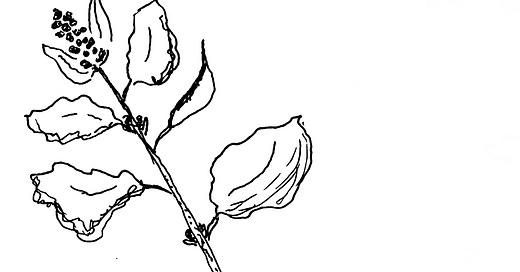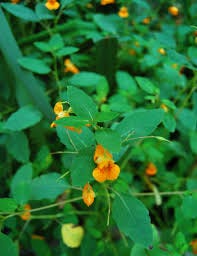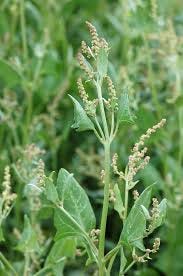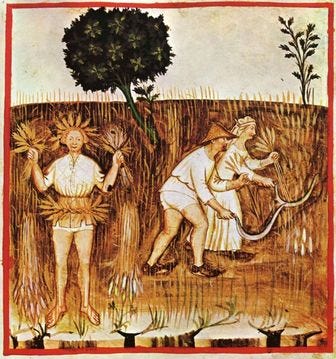ALSO KNOWN AS: Chenopodium album, all good, fat hen, bathua wild spinach, dong weed, pigweed, bacon weed
How to know:
a single spike of completely green flowers
lobed leaves
alternate leaves all down the stem
A dusting of white at the top with silver undersides.
Only a touch a burgundy throughout the plant
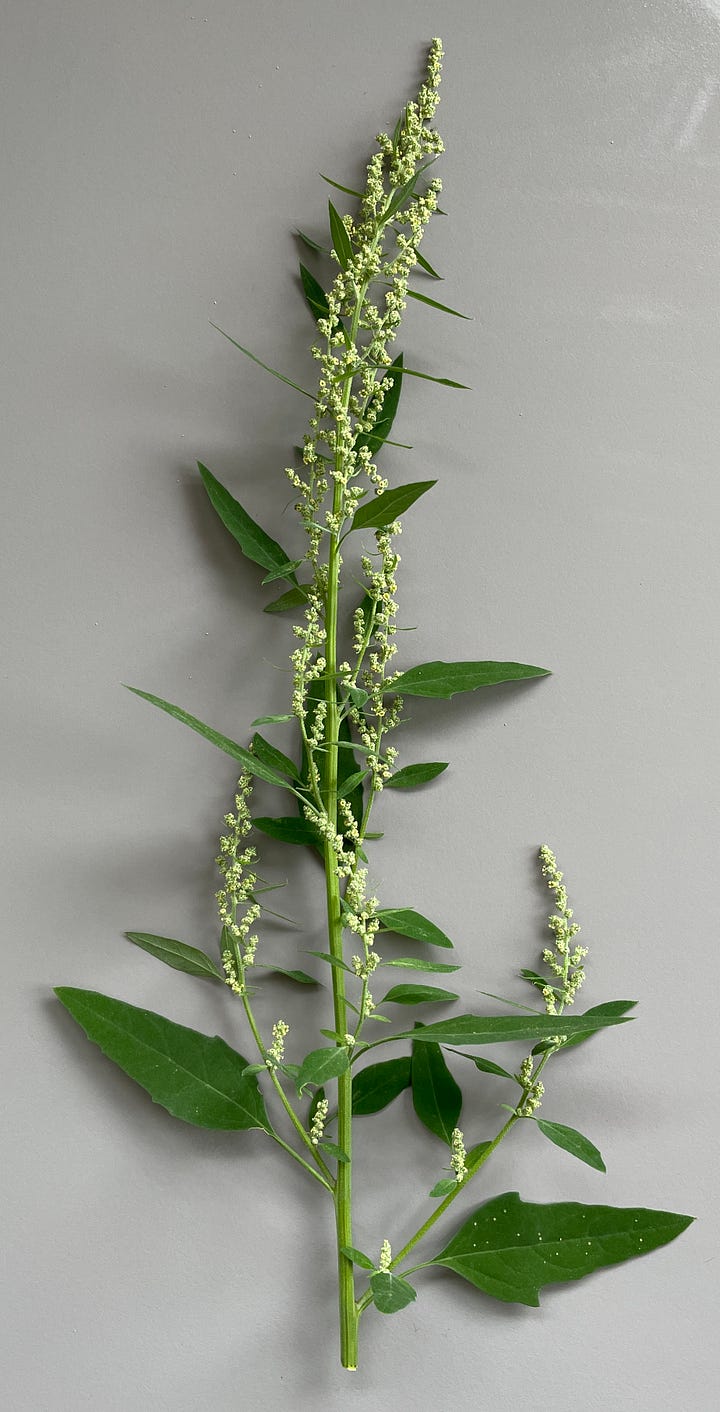
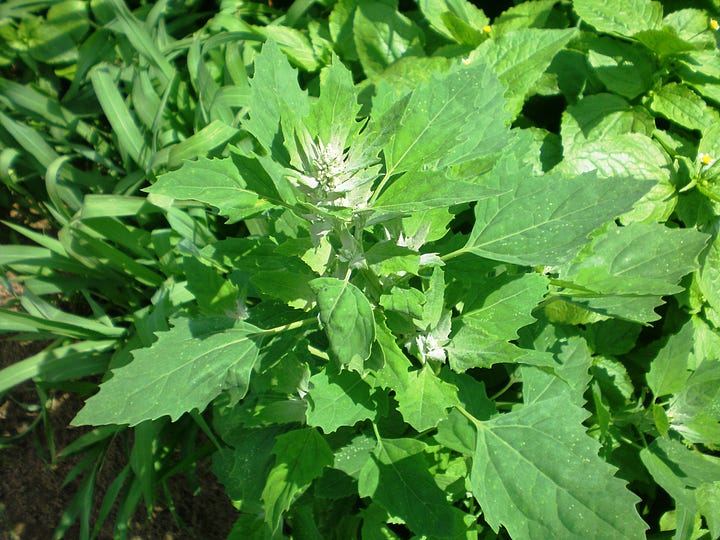
If we learn nothing else in this journey about plants, we must understand that no matter how dully green or tiny, drooped or frayed a plant is, it has a story that is longer than we can imagine. These weeds we walk by are deeply important, and may touch our lives in surprising ways.
This plant is considered a weed. It is But lamb’s quarter has been so valuable entire towns have been named after it. My ancestors in Northern Europe might have honored them at the same time of individuals all over the world. This plant has traveled.
A plant with many faces and even more names
There isn’t a specific “native” region specific to lamb’s quarter. It might have originated somewhere in north Western Asia or mid-to-north Eastern Europe. Lamb’s quarter came to the Americas long before colonization started and has been used throughout the globe from India to Northern Europe and the Americas for perhaps thousands of years.
The lamb’s quarter is part of the amaranth family, a star-studded group that grow easily in many environments, and that humans have learned to work with. This includes quinoa, beets, amaranth (of course), chard, and spinach. It can be eaten just like spinach. In many traditional European dishes what is now spinach was once lamb’s quarter. It has that same sharp taste that spinach, its cousin, has.
Some plants pick up names as they go, like a traveler whose story has everyone in love with them by the end of the evening. Lamb’s quarter grows everywhere. It’s leaves can take on different shapes depending on its environment, it’s height can change. Indeed, sometimes it’s hard to identify. Lamb’s quarter so easily hybrids with other amaranth species that they gladly change their form.
Like many wild plants the lamb’s quarter seeds can be very patient. Their seeds have been harvested for a grain to be prepared like quinoa, but if their seeds mature and fall from the plant they can stay in the soil for forty years.
In a tactical maneuver, the female flowers mature before the males as a way to cross pollinate with other plants and keep their gene pool diverse. Long stalks rise up, about three feet in height with a stake of naked flowers. These flowers have no petals. They’re just soft green - just like the whole plant. All that separates it from the grassy companions is a white cast that looks like a powder has been sprinkled on the plant. On the underside of the leaves there is a silverish sheen. The white (which perhaps lends to the persistence of lamb’s quarter as a name) are in fact trichomes. Trichomes are the hair on plants.
Strangely, the hair on this particular species is flattened and cupped like thousands of little shallow bowls along the leaf which, protecting the otherwise satin-textured leaves. As a result, water washes of the plant in beads like drops on a bird’s wing.
Even though this plant has red, it doesn’t mean it’s the same red as other reds. When red is visible in leaves or stems of plants it is almost always a chemical called anthocyanins. This is not the case for lamb’s quarter. Lamb’s quarter has a red tint that we know so well in the beet plant. This redness is called betalain and the health purposes for plants and animals is unclear other than its use as a dye (betalain is also present in purslane). Betalain and anthocynins have never been present together in the same plant.
A grain for the first summer sacrifice
The Latin name for this plant is Chenopodium album, meaning white (album) goosefoot, relating to the most common shape of its leaves. They undulate in soft lobes, like the connected talons of a goose foot. It’s compared to a hen, and a pig, and a lamb. There is little doubt where this plant has lived for millennia. Lamb’s quarters grows in marginal soils. Historically if it has not been found in a garden its found on the outskirts of a farm, growing optimistically in whichever soil is available. From this soil their taproot sucks up pollution and metals in the soil. So even though lamb’s quarter is entirely edible, from seed to root. The roots and seeds can also be ground and used as soap.
In, primarily, Northern India it is used for daals and ratias, and it is eaten throughout Asia as a leafy green. The lamb’s quarter is rich in vitamin A, C, and B and countless minerals that it’s drawn up from deep in the soil. It has omega 3 and omega 6 fatty acids. It is enjoyed and eaten by people, livestock, and wild animals in all of its ecosystems. There is a sense that it carries its name “all good” hold true.
But like its many names and shapes, it also absorbs much of what is in its soil and can become toxic if pollutants are present.
Lamb’s quarter follows the till of the soil.
Some plants love to break up rock, like moss. Some love a tree to grow on. Some plants love marshland, inundated with water, and some grow after soil has been disrupted. Not only did lamb’s quarter seeds get carried by people throughout history, but it has followed those who farm. It grows from disrupted soil, which is why it is prevalent in cities, towns, and places where soil is upturned.
All of these farmyard names that are connected to this plant are not in fact the reason why lamb’s quarter is the first pagan harvest known as Lammas, or “loaf mass” which occurs around August 1, and is a quarter holiday along with candlemas, all saint’s day, and may day. The grain from this plant was harvested and used to make bread, along with any other grains communities had sown. On this, the last days of summer, we can begin the process of looking back. I image what stories the lamb’s quarter would tell in its thousands of years of wandering, and all the people who fell in love with it, despite its dull appearance, it has stories of many worlds.
myth for lamb’s quarter
Not to be confused with jewel weed, though the leaves are a similar shape.
Not orache, which is related, and very similar, there are flowers and seeds shaped like stars.
Forager friendly?
Yes, just don’t eat it for every single meal. Oxalic acid is not great for you. And it shouldn’t be eaten if the soil is polluted in any way, as lamb’s quater brings up toxins from the soil.
Sources
https://extension.wvu.edu/lawn-gardening-pests/weeds/common-lambsquarters#:~:text=Its%20etymology%20may%20be%20traced,by%20greens%20made%20from%20this
https://www.ncbi.nlm.nih.gov/pmc/articles/PMC8123435/
https://www.britannica.com/plant/Amaranthaceae
https://crops.extension.iastate.edu/encyclopedia/common-lambsquarters
https://www.ncbi.nlm.nih.gov/pmc/articles/PMC8670628/
https://www.seacoastonline.com/story/lifestyle/2015/06/05/lambsquarters-among-earliest-invasive-species/34405132007/
https://www.mofga.org/resources/greens/lambsquarters/
https://foodprint.org/real-food/lambs-quarters/#:~:text=Lamb's%20quarters%20is%20common%20in,“wild%20green”%20in%20China.
https://westcoastpagan.com/2019/08/13/lughnasadh-lammas/

